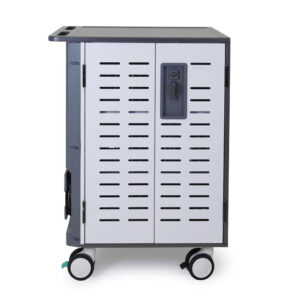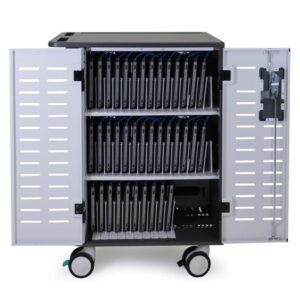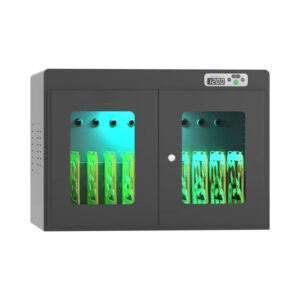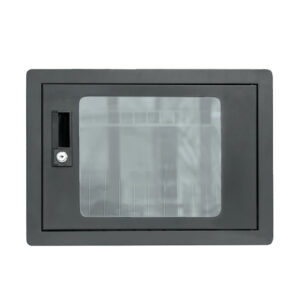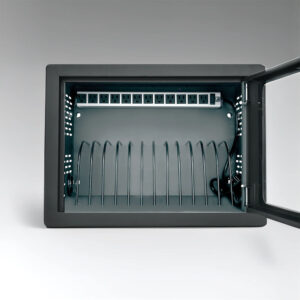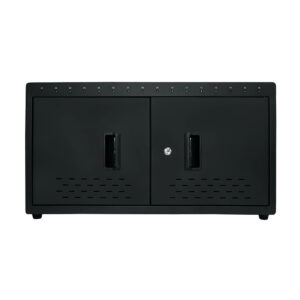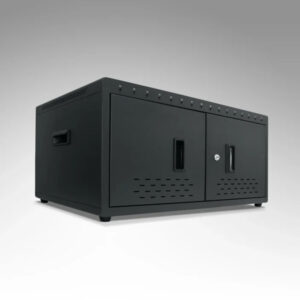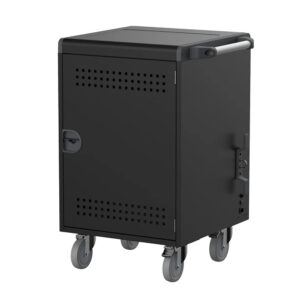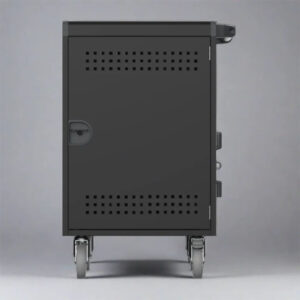Summary
Charging cabinets, also known as charging stations or carts, are specialized units designed to efficiently store and charge multiple electronic devices, such as laptops, tablets, and smartphones, within educational and office settings. Their increasing adoption stems from the need for effective management of technology in environments that heavily rely on digital devices for learning and productivity. Notable for their ability to streamline access to fully charged devices, charging cabinets enhance operational efficiency, support digital learning initiatives, and promote a secure environment for device storage.
The benefits of using charging cabinets include improved device management, as they allow for centralized storage, ensuring that technology is readily available without downtime for recharging. By facilitating immediate access to devices, these cabinets empower educators to incorporate technology seamlessly into their lessons, fostering innovative teaching methods and enhancing the learning experience. Moreover, charging cabinets are considered a cost-effective investment, as they help reduce loss, theft, and damage, ultimately saving institutions money in device replacement costs over time.
In addition to these advantages, charging cabinets significantly enhance security by offering controlled environments with built-in locking mechanisms to prevent unauthorized access. This feature is particularly important in schools, where devices are often shared among students. Furthermore, as educational models increasingly shift toward remote and hybrid learning, charging cabinets provide critical support for managing device availability and minimizing loss during transitions between in-person and online education.
Despite their numerous benefits, there are considerations regarding the initial investment costs and the need for ongoing maintenance to ensure their effectiveness and longevity in educational and office settings. Nonetheless, the positive user experiences and successful case studies illustrate the transformative impact of charging cabinets in enhancing device management and security while supporting a modern, technology-driven educational environment.
Table of Contents
Benefits of Using Charging Cabinets
Charging cabinets, also referred to as charging stations or carts, offer several advantages for educational institutions and offices that utilize multiple electronic devices. These secure storage units are designed to charge devices like tablets, laptops, Chromebooks, and smartphones efficiently, ensuring they are ready for use when needed.
Efficient Device Management
One of the primary advantages of charging cabinets is their ability to streamline device management. With devices stored in a central location and always charged, users can quickly access the technology without delays for recharging. This immediate availability enhances productivity and allows educators and staff to focus more on their tasks rather than troubleshooting device issues.
Promotes Digital Learning
Charging cabinets play a significant role in promoting digital learning by integrating technology seamlessly into the classroom. By ensuring that devices are always charged, teachers can incorporate interactive lessons and digital resources into their curriculum with confidence. This consistent access encourages innovation in teaching methods, allowing educators to experiment with new digital tools and strategies that enhance the overall learning experience.
Cost-Effective Solution
While the initial cost of investing in charging cabinets might be perceived as high, they are ultimately a cost-effective solution for educational institutions. By safeguarding devices from loss, theft, and damage, charging cabinets help reduce replacement costs significantly. Furthermore, they improve operational efficiency, which can lead to long-term savings for schools and offices.
Enhanced Security
Charging cabinets enhance the security of electronic devices by providing a controlled environment for storage and charging. With built-in locking mechanisms and secure access, these cabinets help prevent theft and unauthorized use, protecting valuable assets. This security feature is particularly beneficial in educational settings where devices are frequently shared among students.
Supports Remote and Hybrid Learning
In an era where remote and hybrid learning models are becoming more prevalent, charging cabinets also facilitate asset tracking and management of devices used in these settings. By ensuring that devices are charged and ready for students, these cabinets support the continuity of education, whether in-person or online, and help minimize the risk of device loss during transitions.

Features of Charging Cabinets
Charging cabinets, also referred to as charging stations or charging carts, are specialized units designed to efficiently store and charge multiple electronic devices. These cabinets are equipped with a variety of features that enhance their functionality, making them particularly beneficial in educational settings and offices.
Security Features
Security is a primary concern for institutions managing numerous electronic devices. Most charging cabinets come equipped with lockable doors, often featuring a combination lock or digital padlock, to prevent unauthorized access. Additionally, many cabinets provide options for securing the entire unit to an immovable point, thereby mitigating the risk of theft or misuse. This dual-layered security approach ensures that devices remain protected both when stored and during transport.
Design and Capacity
Charging cabinets are designed to hold a significant number of devices simultaneously. Many models can accommodate between 10 to 36 devices, including laptops, tablets, and smartphones. They often feature adjustable shelves and dividers, allowing for the storage of devices of varying sizes, which helps prevent overcrowding and ensures safe handling. This flexibility is crucial for adapting to different class sizes and device types throughout the academic year.
Efficient Charging Technology
Charging cabinets utilize advanced technology to optimize the charging process. Features such as ECO Safe Charge™ manage power distribution efficiently, preventing devices from overcharging and prolonging their lifespan. Some models allow for staggered charging, enabling multiple devices to charge in intervals, thus reducing heat buildup within the cabinet and enhancing device safety.
Portability and Design
Many charging cabinets are designed for ease of movement. They often include features such as sturdy wheels or a compact footprint, allowing for easy transport between classrooms or offices. The design typically emphasizes space efficiency, with some units being small enough to fit in tight spaces, such as under counters or against walls.
User-Friendly Features
User experience is also a critical aspect of charging cabinets. Features like universal multi-device compatibility enable these units to charge various types of devices without requiring specific adapters. Furthermore, they often come with organized cable management systems to keep cords tidy and prevent tangling, thereby streamlining the charging process and minimizing clutter.

Case Studies
Implementation of Charging Solutions in Educational Institutions
Charging cabinets have proven to be effective tools in various educational settings, enhancing device management and user satisfaction. For instance, the Merced Union High School District in Atwater, CA, has embraced eco-friendly practices alongside implementing modular charging solutions. By integrating photovoltaic systems with smart charging cabinets, the district anticipates significant energy savings while ensuring that devices are securely managed and accessible for students. This innovative approach is expected to save the district approximately $4.3 million over 28 years, showcasing a commitment to sustainability and efficient resource management.
Positive User Experiences
User testimonials further illuminate the effectiveness of charging cabinets in schools. D. Wilson, an IT Technician, remarked on the significant value of modular power stations, stating, “This solution has been the ideal method for us to safeguard our investment throughout the school!”. Similarly, G. Roberts, a Network Manager, emphasized the positive reception of charging devices, noting that “the device has been well-received by both the pupils and staff and will be a lasting addition in the classroom for many years ahead!”. Such feedback highlights not only the practical benefits of charging cabinets but also their role in enhancing the learning environment.
Addressing Educational Challenges
Charging cabinets have effectively addressed several challenges faced by educational institutions, including device management, security, and accessibility. A Director of Technology shared insights on the initial impressions of the charging solution, stating, “Our first impressions were good; we liked how it looked, so we tried it, we loved it, and two years later we haven’t looked back!”. This reflects a strong endorsement of the charging cabinets’ design and functionality, which has led to increased reliability and ease of use in educational settings.
Moreover, the implementation of such technology has allowed educators to focus more on teaching rather than troubleshooting. As schools have transitioned to hybrid learning models, the need for reliable and secure charging solutions has become even more crucial. Charging cabinets facilitate asset tracking in remote education settings, ensuring that devices remain accounted for and functional, thus supporting continuous learning experiences for students.

Management and Maintenance
Effective management and maintenance of charging cabinets are essential for ensuring their longevity and optimal functionality in schools and offices. A well-organized system not only prevents equipment breakdowns but also enhances the overall user experience.
Asset Reservation and Scheduling
Implementing a reservation system for charging cabinets allows staff to plan their usage effectively. By enabling advance bookings, educators can ensure that the necessary equipment is available when needed, reducing the risk of curriculum disruptions due to unavailability of devices. Moreover, this system promotes accountability among users, as they can be held responsible for any failure to return items, fostering a culture of responsibility.
Maintenance Scheduling
Regular maintenance of charging cabinets is vital to prolong their lifespan. Establishing a digital reminder system for maintenance dates can help prevent the neglect of upkeep, which is particularly crucial for high-demand equipment. This proactive approach allows for timely inspections and repairs, ensuring that potential issues are addressed before they escalate into significant problems. Furthermore, tracking maintenance activities helps to ensure that equipment remains safe for use, thereby protecting both students and staff.
Digital Asset Management
Digitalizing asset data streamlines the management process for charging cabinets. Cloud-based inventory systems provide staff with easy access to information regarding the availability and condition of equipment. Such systems also notify users of upcoming maintenance dates, allowing for better planning around equipment availability and minimizing disruptions during school hours. By maintaining an up-to-date digital record of equipment status, schools can also make informed decisions about repairs versus replacements, ensuring cost-effectiveness in asset management.
Condition Monitoring
Monitoring the condition of charging cabinets is crucial for their effective management. An asset management platform can provide insights into the physical state of the equipment, enabling staff to identify issues such as physical damage or suboptimal storage conditions. This capability allows for immediate action to be taken, preventing further deterioration and maintaining the safety of users.



